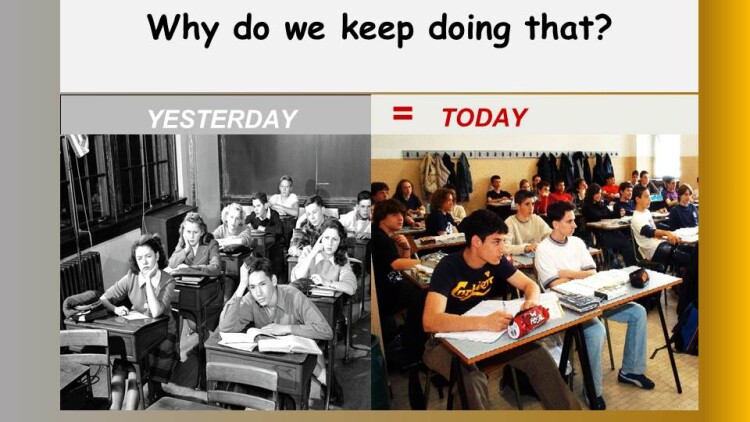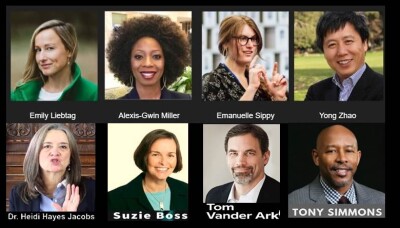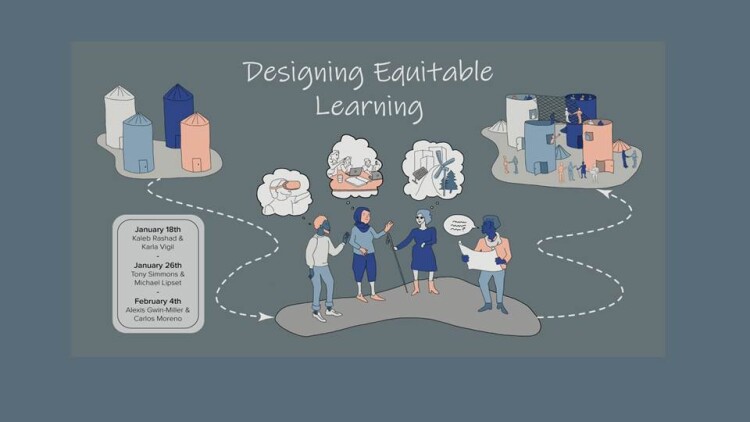
THE POWER OF GATHERING – THE ELEMENTS OF TRANSFORMATION
by Nathan Strenge
Senior Learning Designer at Fielding International
.

Why do we keep doing that to our kids? This is the question that I get a lot from teachers, from parents and I get a similar question from young people. Why do we keep doing that? Why do we keep putting young people in classrooms where they’re sitting down for most of their day, where they’re being talked to for much of their day. Why aren’t our learning experiences connecting to something outside the walls of the school? Why don’t kids have more to say in what they’re learning or how they’re learning? Why aren’t we using the community as learning spaces? And why are we being assessed on these things that have very clear, simple answers, why don’t we work out things that are more authentic and complex and challenging that really force us to think critically, creatively? These questions are really at the heart of what we’re thinking about in education right now. We see visions around the world in schools that are: “we want our kids to be creative thinkers and problem solvers and compassionate and empathetic. We want our kids to be lifelong learners. We want our kids to have agency. We want them to be citizens. We want them to have literacy in numbers and words and writing and reading. We want them to be digitally literate.” These visions for what the future of learning is are often very much misaligned with what schools are doing right now. So this question, why do we keep doing that to our kids is such an important question to explore.
 So, I work at Fielding International as a senior learning designer. And also, I am the United States Country Lead for Hundred, which is a Finnish non-profit organization that brings together the most innovative things in the world in education each year. And between these two roles, I hear questions like “why do we keep doing that to our kids” all the time. But I also get to have conversations with people at local level and at global level around what’s going on right now to start closing those misalignments, to start creating environments and learning ecosystems that really are getting to the roots of that question.
So, I work at Fielding International as a senior learning designer. And also, I am the United States Country Lead for Hundred, which is a Finnish non-profit organization that brings together the most innovative things in the world in education each year. And between these two roles, I hear questions like “why do we keep doing that to our kids” all the time. But I also get to have conversations with people at local level and at global level around what’s going on right now to start closing those misalignments, to start creating environments and learning ecosystems that really are getting to the roots of that question.
ALIGNING YOUR LEARNING ECOSYSTEM

And so today I’m going to talk about a few things, the things that we’re doing at both Fielding International and at Hundreds that are really bringing this idea of how do we create online learning ecosystems that are getting to the vision, so that kids really do have agency, that they are cultivating the sense of curiosity and creativity, that they’re learning real skills, they’re uncovering content through the process of authentic challenges. They’re not passive recipients of antiquated content, but uncovering content that is relevant, complex and very real to their lives in the world around them. So one of the things that I learned personally in my role at Fielding International and Hundred is the power of gathering. I know that it sounds simple, but gathering together, creating time and space, that brings people together in really authentic and organic ways and can be really powerful and I’ll talk about that for a little bit.
So what my role is as a learning designer at Fielding and part of my role at Hundred as a Country Lead is really just few things:
- bringing people together
- asking really good questions and
- listening with empathy.
And anybody can do that. And I want to talk about what we’ve done over the last year from both a global perspective and a local perspective, because both are really important. When we gather globally we can forge new connections, we can spark new ideas, we can share our best practices, we can build and support on one another’s best work. And over the course of the last year, with a lot of the work that we’re doing going virtual. We’ve had a chance to do this and learn from this, and I want to share a few experiences.
Early on in late March, when the Covid pandemic was shutting down schools and businesses and locking down communities all over the world, we at Fielding International thought it was a good time to use this moment, this level of disruption, to consider “what can we come out of this with?”
So we hosted this series called “From Gathering to Transformation”. It brought together over a thousand participants from all countries and almost all states over eight weeks, and it was a really simple format. We brought together a keynote speaker who is really at the cusp of what the future of learning might be.

We brought folks like Yong Zhao and Emily Liebtag, Ewan McIntosh, Heidi Hayes Jacobs, Suzie Boss, Tom Vander Ark and Tony Simmons. These folks gave us a picture not only of what could be, but what’s happening right now, how we can leverage best practices that we’ve learned before Covid, that we can apply beyond Covid because we have so much more understanding of what’s possible. And because we have more freedom and liberation to explore these new ideas, because the level of disruption has created demand for rethinking what education might be. So in this series “From Gathering to Transformation” we had these keynote speakers, but we broke out into small groups, groups of small size around a guiding question or two. And we started generating actions that we could take. And so many amazing things came out of that. I could spend hours just talking about conversations we had with folks around the world, around what the future of learning could be and actions we can take at global, national and local levels.

In that direction one of the things, very concrete things that came out of “From Gathering to transformation” was a film festival that we hosted in October with partners all over the world. Hundred was a partner, Education Reimagined was a partner, Next Generation Learning Challenges was a partner. There were others as well. I won’t list them all, but this film festival is a virtual film festival, it was the first of its kind. The film festival took place at the intersection of race, education and youth empowerment. We brought together an amazing slate of films. Documentary films that showed what’s possible, but also look at the history of race and injustice. And how that manifested into our system of education.
The site of this festival still lives, I can share that with you if you’re curious, just reach out to me @NathanStrenge, you can find me on LinkedIn or Fielding international Web site. and I’ll share that with you.
DESIGNING EQUITABLE LEARNING

Just this last couple of months, I’ve had a chance to work with some amazing folks around equity in education, and we put this series on, called Designing Equitable Learning. And we brought together this community that really is thinking about what does it mean to design learning ecosystems and learning experiences that are really cocreated with young people, that are meant to create difference makers in the world that really, truly, gives young people voice and power to explore, explore themselves, their identity, but also explore how they can become contributors to the world around them. It’s an unbelievable series, and you can find the recordings of Designing equitable learning on our website at Fielding International.
We come to this idea that when we gather, whether it’s in person or virtual, whether it’s global, or national, or local, we can spark ideas, we can generate actions, we can humanize one another. It doesn’t mean that we’re singing Kumbaya, or that we have to agree on everything. But it means we’re living with love, compassion. And we’re putting our young people first. So ultimately, gathering in a big global national communities can be great, but what we also found is that the change in education it’s going to happen locally, it’s going to happen at the school level. It’s going to happen at the district or community level.
And so what I want to ask you now is: what can we do with gathering in local communities? What we’ve done at Fielding is put together a workshop called “Align to thrive”. And it’s based on this notion that when we start identifying our misalignment in our systems we can start to create connected online learning ecosystem where our vision for learning and our environments of where we learn and our human capacity, and roles within the ecosystem, the roles of the adults, the role the young people can all work together to strengthen and support one another. And we certainly bring in our global expertise in designing spaces and environments, and we have design patterns that really illuminate what an alignment ecosystem can be.
We have some of our design patterns, like our learning community model and our spaces and our indoor-outdoor connections that resonate with people all over the world. And so this the idea of gathering locally: when we do that we bring together young people, we bring together teachers and administrators, and parents and local business owners and we talk about what the purpose of learning is, and then we bring together what can we do to bring in environmental factors and our vision for the thriving learners and our roles of people in that ecosystem. It’s incredibly powerful.

What we’re hearing from people all over the world right now is there’s this transition from covering content as the primary principle of design to moving towards authentic challenges that uncover content and engage kids in real problem solving in their communities. And I want to shout out to a couple of friends of mine, Emily Liebtag and Tom Vander Ark for their book, I can’t stress enough, read this book, it just came out in the last few months, “Difference making at the heart of learning”. It shows us what’s possible, what’s already happening around the world.
CREATE YOUR ECOSYSTEM

So I spoke about our work at Fielding International. I spoke a little bit about Hundred, this idea that we can bring together ideas that are making changes, that are working towards a more sustainable and equitable world. Hundred’s website has all of these different things that are happening that can be applied at the local level. So check their website out, check us out at Fielding, where we can help you have these conversations where we can gather and start aligning your learning ecosystem. But you don’t have to come to us, you can do it on your own. You can create that time and space and gather.
If you can embed young people in that process to get them leading and co creating with you, that’s when the magic happens.
We’re happy to do that with you, to help you co-create that together. But you don’t have to wait for us. You can do it on your own, and when you do it, you’re going to start creating an aligned learning ecosystem where every single person, young people and adults in that ecosystem, are seen as incredible human beings that have the capacity to do anything they set their mind to, heard for what they want to do, valued for who they are as a unique individual.
When we do this, when we bring people together, we can actually start addressing issues in our world, we can use education as a platform to address real world problems because there are so many right now, you can look through a lens a climate or racial injustice, poverty, growing inequalities… There’s so many more. One way to look at it is through the United Nations sustainable goals or you could just start local. What are the problems in your community? When you gather, and talk, and listen that’s when we’re going to start creating the ecosystem all over the world. It’s happening right now in our pockets, we see it all the time at Fielding International and at Hundred, it’s happening. You can do it too. Thank you.



